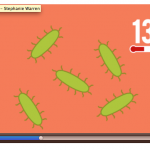Fighting the boredom, part 3: “Become a better scientific communicator by experiencing it.”
 In this third part of his four part blog article, Leonidas Georgiou gives some examples of communicators who inspire him.
In this third part of his four part blog article, Leonidas Georgiou gives some examples of communicators who inspire him.
Who is a good communicator? I think one of the best ways to becoming a better scientific communicator is to experience it. Many of us go through our lives being taught by a great majority of bad communicators. Fortunately, today we have the Internet that gives us the opportunity to compile some of the best communicators and ask what makes them awesome.
In my opinion, the people below are very good communicators. They are excellent storytellers and via a collection of presentation skills, they convey their message clearly in an engaging manner. Of course, there are many more excellent communicators out there, we just need to find them and learn from them. So, who do you think is a great communicator? Share your opinion with us and what you think makes them great!
Sir Ken Robinson
Who is he? Education communicator; presented the most popular TED talk.
Video: Ken Robinson says schools kill creativity
Highlight: Humour
Great because: Good storytelling and tone of voice. Entertains and engages audience.
Note: No presentation slides, yet number one ted talk.
Neil DeGrasse Tyson
Who is he? Physics communicator
Video: Tyson on how long until we go to another galaxy
Highlight: Humour
Great because: Engagement with audience, tone of voice, body language, repetition of hard to remember information, drama.
Note: Again, no presentation slides!
David Attenborough
Who is he? World famous nature communicator
Video: Attenborough on carnivorous plants
Highlight: The viewer experiences a first person perspective.
Great because: Tone of voice, enthusiasm, combines good camera footage and narration.
Note: No notes, David Attenborough is a legend
Hans Rosling
Who is he? Data and statistics communicator
Video: Rosling on the magic washing machine
Highlight: Illustration of points and data.
Great because: Theatrical narration, empathise with presenter (use of personal experiences), tone of voice, body language, excellent use of technology, excellent slide transitions.
Note: When slides are not optimal, he uses other methods to illustrate points and engage the audience (a washing machine in this case). He uses slides when needed to illustrate his points and data. He illustrates data instead of bombarding the audience with numbers they will forget and not help him pass the points he wants.
The other blog posts in this series:
Part 1: Fight the boredom
Part 2: ”It’s up to you to make it interesting!”
Part 4: Some recommended YouTube science channels





Leave a Reply
Want to join the discussion?Feel free to contribute!